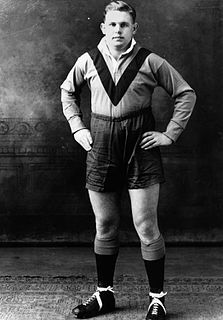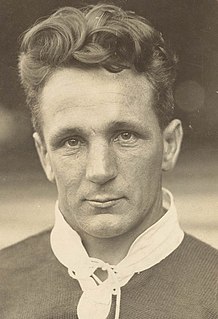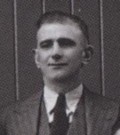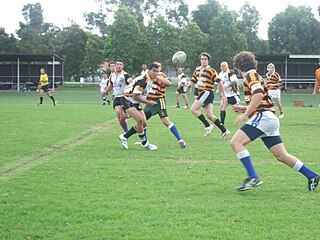Related Research Articles

The New South Wales Rugby League (NSWRL) is the governing body of rugby league in New South Wales and the Australian Capital Territory and is a member of the Australian Rugby League Commission. It was formed in Sydney on 8 August 1907 and was known as the New South Wales Rugby Football League (NSWRFL) until 1984. From 1908 to 1994, the NSWRL ran Sydney's, then New South Wales', and eventually Australia's top-level rugby league club competition from their headquarters on Phillip Street, Sydney. The organisation is responsible for administering the New South Wales rugby league team.

The Australian national rugby league team, the Kangaroos, have represented Australia in senior men's rugby league football competition since the establishment of the 'Northern Union game' in Australia in 1908. Administered by the Australian Rugby League Commission, the Kangaroos are ranked fourth in the RLIF World Rankings. The team is the most successful in Rugby League World Cup history, having contested all 15 and won 11 of them, failing to reach the final only once, in the inaugural tournament in 1954. Only five nations have beaten Australia in test matches, and Australia has an overall win percentage of 70%.

Herbert Henry Messenger, nicknamed "Dally" and sometimes "The Master" was one of Australasia's first professional rugby footballers, recognised as one of the greatest-ever players in either code. He played for New South Wales in the first match run by the newly created 'New South Wales Rugby Football League' which had just split away from the established New South Wales Rugby Football Union.

Rugby league in Australia has been one of Australia’s most popular sports since it started being played there in 1908. It is the dominant winter football code in the states of New South Wales and Queensland. In 2009, it was the most watched sport on Australian television eclipsing the AFL nationally with an aggregate audience of 128.5 million viewers. The elite club competition is the National Rugby League (NRL), which features ten teams from New South Wales, three teams from Queensland, and one team each from Victoria, the Australian Capital Territory and New Zealand.
Barry Muir is an Australian former professional rugby league footballer and coach. An Australian and Queensland representative halfback, he played in twenty-two Tests between 1959 and 1964, as captain on two occasions.

Clive Bernard Churchill AM was an Australian professional rugby league footballer and coach in the mid-20th century. An Australian international and New South Wales and Queensland interstate representative fullback, he played the majority of his club football with and later coached the South Sydney Rabbitohs. He won five premierships with the club as a player and three more as coach. Retiring as the most capped Australian Kangaroos player ever, Churchill is thus considered one of the game's greatest ever players and the prestigious Clive Churchill Medal for man-of-the-match in the NRL grand final bears his name. Churchill's attacking flair as a player is credited with having changed the role of the fullback.

Harry Bath, born Alfred Henry Bath, also known by the nickname of "The Old Fox", was an Australian rugby league footballer and coach who was prominent and influential in the mid-20th century. A state and international representative who played 12 matches for Other Nationalities in the International Championship from 1949 to 1955, he played as a second-row and has been referred to as the best Australian rugby league player never to be picked for the Australian national team. Following his retirement, Bath coached in the New South Wales Rugby Football League premiership for two decades, also achieving selection as the Australian national team coach.

Ross McKinnon (1914-1962) was an Australian rugby league footballer and coach. Born in Oberon, New South Wales, he played for the University, Eastern Suburbs, New South Wales and for the Australian national side.

Victor John Hey, also known by the nickname of "The Human Bullet", was an Australian rugby league national and state representative five-eighth and later a successful first-grade and national coach. His Australian club playing career commenced with the Western Suburbs Magpies, and concluded with the Parramatta Eels. In between he played for a number of clubs in the English first division. He is considered one of Australia's finest footballers of the 20th century
The Newcastle Rugby League is a local rugby league football competition in Newcastle, Australia. It is one of the oldest rugby league competitions in Australia, founded in 1910. A Newcastle representative team was also assembled from players in the League during most of the 20th century. The first grade competition also comprises the NSWRL Presidents Cup Northern Conference.

Patrick Bernard "Nimmo" Walsh was a pioneer Australian representative rugby union and rugby league footballer, a dual-code international, who saw active duty with the Australian Imperial Force in the first World War. He represented the Wallabies in three Tests in 1904 and the Kangaroos in three Tests on the first tour of Great Britain in 1908–09.

Jim Craig (1895–1959) was an Australian rugby league footballer and coach. He was a versatile back for the Australian national team. He played in seven tests between 1921 and 1928 as captain on three occasions and has since been named amongst the nation's finest footballers of the 20th century. Craig was a player of unparalleled versatility. It is known that he represented in Tests at fullback, centre, halfback and hooker with some of his club and tour football played at winger, five-eighth and lock forward. Whiticker's reference reports that the great Dally Messenger regarded Craig as the greatest player Messenger ever saw.
Brian Clinton Hambly was an Australian rugby league player, a representative forward for the Australia national team between 1959 and 1965. His club career was played with South Sydney and Parramatta. He was considered one of the Australia’s finest rugby league players of the twentieth century.
Kelvin Joseph "Kel" O'Shea was an Australian representative rugby league footballer, a second-rower from Queensland whose club career was played with the Western Suburbs Magpies in Sydney. He is rated among the nation's best players of the 20th century.

Norman "Latchem" Robinson was an Australian professional rugby league footballer, coach, selector and club administrator for the Balmain Tigers club in Sydney and a City, State and National selector and manager. He also served as NSW and Australian coach in 1948 and 1958 respectively.

Rugby league, in New South Wales, is the most popular participation and spectator sport. It currently has the highest attendance and television audiences of the various codes of football in the state, far outstripping any other competitors. The state has over 400,000 active participants in the sport with a further 1 million playing the sport in schools, over 500 active clubs across the state, and 10 clubs in the national professional competition, named the NRL.
Frank Stanmore (1929–2005) was an Australian rugby league footballer who played in the 1940s and 1950s. An Australian international and New South Wales interstate representative five-eighth, he played club football in Sydney's NSWRFL for Western Suburbs, winning the 1948 Premiership with them. Stanmore also played in the Newcastle Rugby League and was inducted into the Hunter Region Sporting Hall of Fame.

Charlie Gill (1923–1986) was an Australian rugby league footballer who played in the 1950s. An Australian international and New South Wales interstate representative forward, he played club football in the Newcastle Rugby League for Norths and Wests and also spent a season in Sydney's NSWRFL Premiership with Parramatta.
The Newcastle rugby league team is a representative rugby league football team made up of players selected from the Newcastle Rugby League's first grade clubs. Also called Newcastle Firsts, the team has been assembled occasionally since rugby league's first season in Australia in 1908.
The 1920 Great Britain Lions tour was the third British national rugby league team or 'Lions' tour of Australasia, where it was winter and matches were played against the Australian and New Zealand national sides, as well as several local teams. In Australia, the three-Test match series was won by the hosts. In New Zealand another three-Test series was played and won by the visitors. The tour was a success and brought in a handsome profit.
References
- ↑ Rugby League Project
- ↑ NRL Stats [ permanent dead link ]
- ↑ "Display". Archived from the original on 25 April 2012. Retrieved 6 November 2011. Banks at the Newcastle Sporting Hall of Fame
- ↑ Bob Banks at the Sporting Pulse homepage for Northern Division
- ↑ Goodman, Tom (28 May 1959). "Queensland beats N.S.W. in league by 17-15". The Sydney Morning Herald . Retrieved 11 December 2011.
- ↑ Pollard, Jack (1965). Gregory's Guide to Rugby League. Australia: Grenville Publishing. p152.
- ↑ "Robert Banks". Department of the Prime Minister and Cabinet. Archived from the original on 4 March 2016. Retrieved 6 January 2012.
- ↑ Leslie, Cameron (21 August 2008). "Rugby League Team of the Century named". The Chronicle . Retrieved 8 January 2012.
- Alan Whiticker & Glen Hudson (2007). The Encyclopedia of Rugby League Players. Wetherill Park, New South Wales: Gary Allen Pty Ltd. p. 20. ISBN 978-1-877082-93-1.
- Malcolm Andrews (1992). ABC of Rugby League. Sydney, New South Wales: ABC Enterprises. p. 35. ISBN 0-7333-0176-2.